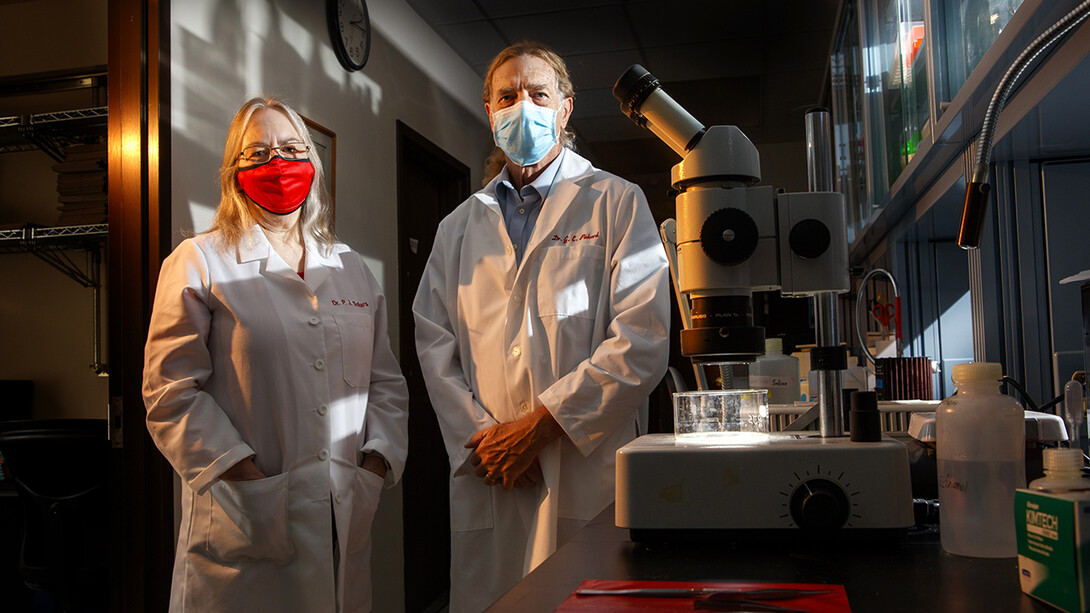
The extraordinary smash-and-grab of a molecular motor from one type of cell may explain how herpesviruses power their way to the sanctuary-granting, replication-enabling nucleus of another, says a new study in the journal Nature.
Researchers from Northwestern University, the Albert Einstein College of Medicine and the University of Nebraska–Lincoln made the discovery while studying alphaherpesviruses, which include the cold sore-causing herpes simplex virus 1 and the sexually transmitted herpes simplex virus 2.
Nebraska’s Gary Pickard and Patricia Sollars, Northwestern’s Greg Smith and colleagues have been developing an alphaherpesvirus vaccine platform that recently outperformed another leading candidate in animal trials. That vaccine works in part by thwarting an especially diabolical quirk of alphaherpesviruses: their ability to enter the nervous system, where they take refuge from immune responses and persist for a lifetime in their hosts, human or otherwise.
Alphaherpesviruses initially infect epithelial cells around the mouth or genitourinary tract before seeking asylum from the immune system in the sensory nerves that register touch, pain and other stimuli-driven sensations. In some cases, they even make their way to the neurons of the brain.
Researchers knew that alphaherpesviruses could be traveling such distances — the viral equivalent of ultramarathons — only by recruiting help from the host itself. They even knew that the viruses were hijacking so-called motor proteins, which normally shuttle essential materials to and from a cell body along a series of cellular superhighways known as microtubules. Two types of motors, kinesins and dyneins, are programmed to tow cellular freight — often the same cargo — in opposite directions of those superhighways.
“This tug-of-war between kinesin and dynein, that’s ubiquitous in all cells,” said Pickard, professor of veterinary medicine and biomedical sciences at Nebraska. “It’s going on all the time, everywhere.”
The hijacking of dyneins explained how an alphaherpesvirus reaches the body of a neuron after entering a distant nerve terminal. Yet that grand theft alone couldn’t account for how the virus gets to the centrally located nucleus, where it injects its DNA and instructs the host cell to churn out copies of itself. Though kinesins were considered a likely culprit, prior efforts had failed to confirm that suspicion.
But thanks to some technological improvements and methodological inventiveness, the team has now established that kinesins are, in fact, imperative to the entire operation. The bigger surprise? In a gambit that Pickard called “unprecedented,” alphaherpesvirus particles actually steal kinesin motors from their points of entry, then traffic those kinesins over to the cells that they plan to settle in for the long haul.
“The big story here is that the virus is not using the kinesin motor that’s in the neurons,” Pickard said. “It’s taking it from the epithelial cell.”
Multiple analyses and experiments supported the team’s startling conclusion. In one, the researchers raised pseudorabies virus — a pig-infecting alphaherpesvirus — in a line of cells that were engineered not to produce kinesin. Despite still reaching the cell bodies of neurons, the majority of those pseudorabies particles faltered down the homestretch, halting before they got to the nuclei and, consequently, failing to replicate.
That result held even when the invaded neurons were producing their own kinesins, suggesting that the epithelial-based supply of motor proteins is somehow necessary for alphaherpesviruses to successfully infect the nerve cells. And when Pickard and Sollars introduced mice to viral particles raised either without or with a supply of kinesin, only the latter yielded symptoms in the mice.
Beyond the scientific value of discovering another ingenious trick in the alphaherpesvirus arsenal — “For something that’s an inanimate thing, they’ve thought this process out pretty well,” Pickard said — the importance of kinesin trafficking could eventually mark it as a target for antiviral drugs.
“Every time you understand another step, there’s another opportunity to learn more about the virus and potentially make things that are going to alter it,” he said.
Before that, though, lie a plethora of unknowns that the researchers are intent on addressing. For one, there’s the issue of how alphaherpesviruses package the kinesins they pick up in epithelial cells. Another: how, exactly, the viruses regulate the potential tug-of-war between kinesin and dynein, both before and after arriving at a nerve cell.
“What happens when it gets into the cell body? What turns it on? What’s changed when it gets there? There are just a zillion questions we don’t have any idea what the answers are to yet,” Pickard said. “So it’ll keep us busy for a few more years.”
Smith, Pickard and Sollars authored the Nature study with Northwestern’s Caitlin Pegg, Sofia Zaichick, Ewa Bomba-Warczak, Vladimir Jovasevic, DongHo Kim, Derek Walsh and Jeffrey Savas, along with the Albert Einstein College of Medicine’s Himanshu Kharkwal and Duncan Wilson.
The team received support from the National Institutes of Health and the National Science Foundation.







